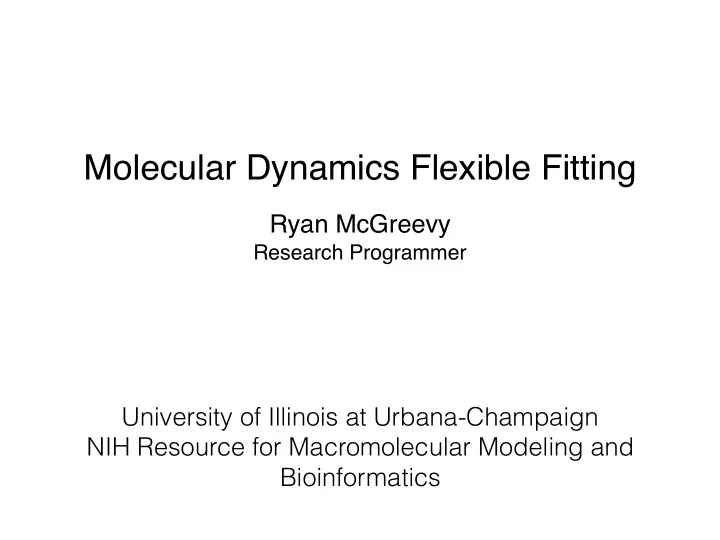

Molecular Dynamics Flexible Fitting Ryan McGreevy Research Programmer University of Illinois at Urbana-Champaign NIH Resource for Macromolecular Modeling and Bioinformatics
M olecular D ynamics F lexible F itting (Ribosome-bound YidC) crystallographic cryo-EM density structure map Match through MD APS Electron Synchrotron Microscope Supercomputer
Molecular Dynamics Flexible Fitting - Theory Two terms are added to the MD potential An external potential derived from the EM map is defined on a grid as A mass-weighted force is then applied to each atom [1] Trabuco et al. Structure (2008) 16:673-683. Acetyl – CoA Synthase [2] Trabuco et al. Methods (2009) 49:174-180.
Secondary structure restraints Harmonic restraints are applied to preserve secondary structure of proteins and nucleic acids, avoiding “overfitting.” For nucleic acids, distance and For proteins, φ and ψ dihedral angles dihedral restraints are applied of residues within helices or beta to a selected set of base pairs. strands are restrained.
Additional Restraints Cis-peptide and Chirality Domain-wise Eduard Schreiner, et al. BMC Bioinformatics, 12, 190, 2011 Acetyl – CoA Symmetry Synthase Translate back Super-impose Average positions of C-alpha atoms Current structure Perfectly symmetric structure Harmonic restraints (strength increasing over simulation for convergence) B. pumilus cyanide dihydratase Kwok-Yan Chan, et al. Structure, 19, 1211-1218, 2011
Simulation Environment MDFF can be run in different environments: 1. Vacuum • No water molecules • Fastest but potentially inaccurate 2. Explicit Solvent • Explicit atomic detail water molecules • Computationally slow and introduces effects of viscous drag 3. Implicit Solvent • generalized Born approximation of electrostatics Tanner, et al. Journal of Chemical Theory and Computation 7(11) 3635–3642, 2011. • Compromise between speed and accuracy
MDFF Software Suite • NAMD and VMD used together to run MDFF • Every NAMD and VMD feature is available in MDFF Input: MDFF only requires a Fitting time is dependent on: PDB, PSF, and density map • system size • map and structure quality Output: produces simulation • Generally need ~ 1ns or less trajectory from which an (much shorter than MD) ensemble of structures can http://www.ks.uiuc.edu/Research/mdff/ be extracted
MDFF Software Suite • system sizes up to 100 million atoms (viruses, chromatophore) • maps from 3 to 15 Å • runs on laptops to petascale computing Interactive GPU-accelerated resources (Blue Cross-correlation Waters, Titan) New MDFF GUI (VMD 1.9.3) makes setting up, running, and analyzing fitting simulations even easier http://www.ks.uiuc.edu/Research/mdff/
Interactive Modeling with MDFF GUI • Apply forces to manually manipulate structure into the density • Useful for difficult to fit structures with large conformational changes Analyze interactive simulations in real- time New MDFF GUI in VMD 1.9.3 Set up and run interactive (or traditional) MDFF/xMDFF simulations
Interactive Modeling Integrates User Expertise
Analyzing MDFF Model Quality: Local Cross Correlation • Local cross correlation indicates quality of fit of specific regions across the entire structure • New parallel CPU and GPU algorithms provide significant speed up ( 25-50x speedup over Chimera ), allowing for fast computation along fitting trajectories Structure is colored by cross correlation, along with Timeline analysis of the trajectory Good Fit Intermediate Fit Bad Fit -.309 .9031 John E. Stone, et al. Faraday Discussion, 169:265-283, 2014
MDFF on the Cloud Costs Less than a Cup of Coffee VMD, NAMD, MDFF now available on Amazon Cloud Focus on the scientific challenges of your project without having to worry about local availability and administration of suitable computer hardware and installing or compiling software Acetyl-CoA Synthase (PDB 1OAO) 11469 atoms, 6 Parallel Replicas Instance Performanc Time Simulation Singharoy, et al . eLife 2016 CPU Type e (ns/day) (hours) Cost ($) c3.8xlarge 30 5.88 0.41 1.68 c3.4xlarge 12 3.33 0.72 0.84 c3.2xlarge 6 1.35 1.78 0.84 Singharoy, et al . eLife 2016 Easy, 1-click launch for fast access to MDFF on HPC hardware
MDFF Has a Wide Range of Applications Over 100 reported MDFF applications: • By intramural Researchers: Schweitzer et al. PNAS (2016): Human 26S Proteasome Cassidy et al. eLife (2016): Chemosensory array Qufei Li et al. Nat. Struct. Mol. Biol . (2014): Structural mechanism of voltage- sensing protein Zhao et al. Nature (2013): All-atom structure of HIV-1 capsid Agirrezabala et al. PNAS (2012): Ribosome translocation intermediates • By extramural Researchers: He et al. Nature (2016): human pre-initiation complex Li et al. Nature (2016): 20S proteasome Barrio-Garcia et al. Nat. Struct. Mol. Biol . (2016): pre-60S-ribosome remodeling Gogala et al. Nature (2014): Ribosome Sec61 complex Unverdorben et al. PNAS (2014): 26S proteasome Bharat et al. PNAS (2014): Tubular arrays of HIV-1 Gag Park et al. Nature (2014) : SecY channel during initiation of protein translocation Hashem et al. Nature (2013): Trypanosoma brucei ribosome Becker et al. Nature (2012): Ribosome recycling complex Lasker et al. PNAS (2012): Proteasome Strunk et al. Science (2011): Ribosome assembly factors MDFF/xMDFF Methodological Articles: Singharoy*, Teo*, McGreevy*, et al. eLife (2016) Full structure of the human 26S McGreevy et al. Methods (2016) 100:50-60 Proteasome McGreevy*, Singharoy*, et al. Acta Crystallographica (2014) D70, 2344-2355 Schweitzer et al., PNAS. 2016 Trabuco et al. Structure (2008) 16:673-683. Trabuco et al. Methods (2009) 49:174-180.
Further Information Find out more about MDFF including: • software downloads • publications • documentation • tutorials http://www.ks.uiuc.edu/Research/mdff/
Recommend
More recommend